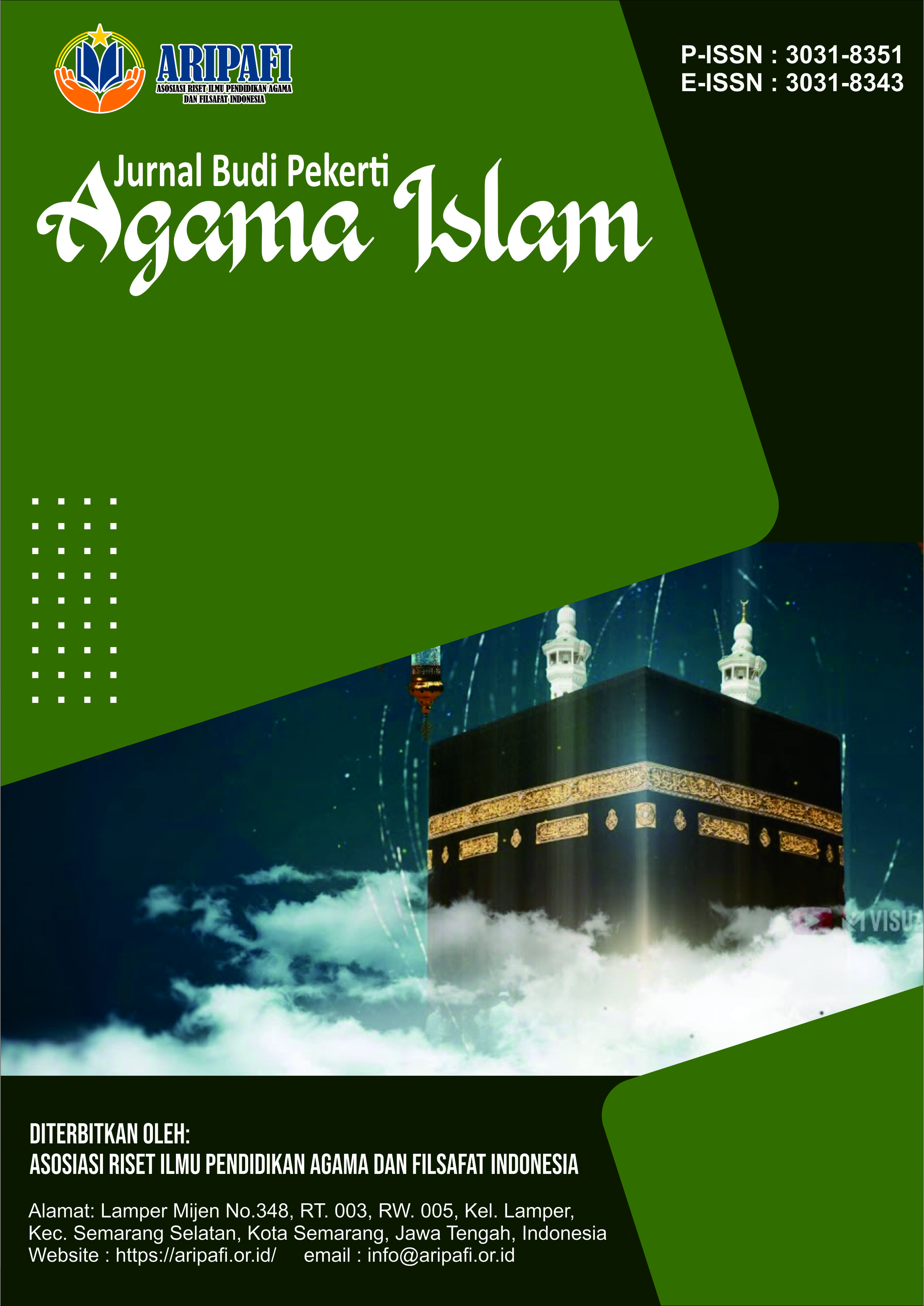Penciptaan Makhluk dalam Perspektif Hadis
DOI:
https://doi.org/10.61132/jbpai.v3i3.1172Keywords:
Creation, Hadith, Islamic Cosmology, Nur Muhammad, QalamAbstract
The This study examines the debate surrounding the first created being in Islamic cosmology, where various opinions exist. Some argue that the first creation was the Pen (al-Qalam), while others claim it was the Throne (‘Arsh), the air, or the Light of Muhammad (Nur Muhammad). The main issue addressed is the limited and fragmented information found in classical hadith sources regarding the sequence and nature of the initial creation. Methodologically, this research employs a qualitative approach by analyzing the chapter Bad’ al-Khalq (The Beginning of Creation) in key hadith collections. The findings show that although some hadiths mention early creations such as the characteristics of heaven and hell, the seven layers of the earth, and angels, detailed and systematic narratives about the order of the first created beings remain scarce. Various views on who or what was created first appear in the literature, ranging from al-Qalam and ‘Arsh to Nur Muhammad, but no absolute consensus has been reached. This study aims to fill that gap by compiling and analyzing relevant hadiths to provide a more focused and in-depth perspective on the first created being and the sequence of creation. Additionally, this research emphasizes the theological and cosmological significance of these beings and their implications for understanding the structure and purpose of the universe. It is hoped that the results of this study will enrich the body of Islamic scholarship and encourage deeper reflection on the orderliness and existence of Allah’s creation.
Downloads
References
Al-Bukhari, M. b. I. (2006). Shahih Al-Bukhari. Dar Al-Fikr.
Amelia, D. (2024). Penyelesaian hadis-hadis kontradiktif antara anjuran larangan menunda salat zuhur ketika cuaca panas. Tahdis, 14, 1–23.
Ash-Shallabi, A. M. M. (2020). Kisah permulaan penciptaan dan penciptaan Nabi Adam A’laihi Salam. Dar Ibn Katsir.
Fadhilah, I. A., & Maunah, B. (2021). Manusia sebagai makhluk yang perlu dan dapat dididik. Cendekia, 15(2), 254–268. https://doi.org/10.30957/cendekia.v15i2.718
Firmansyah. (2025). Konsep multikulturalisme dalam Al-Qur’an (kajian tafsir tematik). [Nama Jurnal], 2(April). (Mohon tambahkan nama jurnal jika tersedia)
Firosad, A. M. (2019). Book review: Menilik keistimewaan penciptaan manusia dalam Islam. Turast: Jurnal Penelitian dan Pengabdian, 4(1), 99–111. https://doi.org/10.15548/turast.v4i1.339
Hafizon, A., Hitami, M., & Yusuf, K. M. (2022). Konsep penciptaan alam (makhluk): Pembuktian penciptaan dan tanggung jawab. Jurnal Penelitian Ilmu Pendidikan Indonesia, 1, 326–331.
Izzuddin, M. (2022). Fiqh bi’ah - Membunuh binatang. Wasathiyyah, 4(2), 51–63.
Jenal, I. (2022). Maksud dan tujuan penciptaan makhluk (Kholiqul Basyar) sebagai landasan religius tujuan pendidikan Islam. Permata, 3(2), 162–182.
Kamal. (2023). Pluralitas makhluk dan keesaan khalik: Membangun peradaban di atas perbedaan. Jurnal Sipatokkong BPSDM Sulsel, 3(4), 274–283. https://doi.org/10.58643/sipatokkong.v3i4.184
Khusnah, F. N. A. (2022). Proses penciptaan manusia dalam Al-Qur’an menurut Tantawi Bin Jawhari. [Nama Jurnal]. (Mohon tambahkan nama jurnal dan volume/halaman jika tersedia)
Muhammad, M. T. (2017). Kualitas manusia dalam pandangan Al-Qur’an. Jurnal Ilmiah Al-Mu’ashirah, 13(1), 1. https://doi.org/10.22373/jim.v13i1.2348
Muslim bin al-Hajjaj al-Naisaburi. (2000). Shahih Muslim. Dar Ihya al-Turath al-Arabi.
Ritonga, M. S. (2018). Alam semesta dalam pandangan filosofi Islam dan ahli tafsir. Alashriyyah, 4(2), 12. http://jurnal.nuruliman.or.id/index.php/alashriyyah/article/view/40
Ritonga, M. S. (2018). Penciptaan manusia. Fitrah: Jurnal Kajian Ilmu-Ilmu Keislaman, 4(1), 1–28. https://doi.org/10.24952/fitrah.v4i1.873
Runtung, S. (2021). Hakikat teologi penciptaan manusia dan implikasinya. Jurnal Ilmiah Mara Christy, 11(1), 7–20.
Sidik, M. A. (2022). Kosmologi dalam pandangan Imam Khomeini. Rausyan Fikr: Jurnal Ilmu Studi Ushuluddin dan Filsafat, 18(1), 45–71. https://doi.org/10.24239/rsy.v18i1.799
Siregar, B. (2021). Pesan moral puasa ‘Asyura dalam pengamalan ibadah masyarakat Desa Paringgonan Kecamatan Ulu Barumun Kabupaten Padang Lawas. Studi Multidisipliner, 8(1), 89.
Tirmidzi. (2000). Sunan Al-Tirmidzi. Dar Ihya al-Turath al-Arabi.
Usman, M., Wasik, W., Zainuddin, A., & Karim, A. M. (2023). Fitrah manusia dalam pandangan Islam. Ulumuna: Jurnal Studi Keislaman, 8(2), 284–298. https://doi.org/10.36420/ju.v8i2.5812
Wahid, A., & Firdaus, H. I. (2022). Hakikat manusia dalam Al-Qur’an: Kajian tafsir tematik. Jurnal Kewarganegaraan, 6(2), 4712–4713.
Wahid, M. A. (2020). Teori mengenai penciptaan manusia dalam hadis Nabi: Kajian ma’anil hadis. Tahdis: Jurnal Kajian Ilmu Al-Hadis, 10(2), 173–189. https://doi.org/10.24252/tahdis.v10i2.12462
Warosari, Y. F. (2022). Konsep penciptaan alam semesta (makhluk) dalam Al-Qur’an. [Nama Jurnal], 19(2), 47–71. (Mohon tambahkan nama jurnal jika tersedia)
Zaenuddin. (2020). Posisi matahari dalam menentukan waktu shalat menurut dalil syar’i. Elfalaky, 4(1), 36–55. https://doi.org/10.24252/ifk.v4i1.14166
Downloads
Published
How to Cite
Issue
Section
License
Copyright (c) 2025 Jurnal Budi Pekerti Agama Islam

This work is licensed under a Creative Commons Attribution-ShareAlike 4.0 International License.





